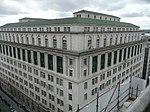Liverpool James Street railway station
Former Mersey Railway stationsMerseyrail underground stationsPages with no open date in Infobox stationRailway stations in Great Britain opened in 1886Railway stations in Liverpool ... and 3 more
Railway stations located underground in the United KingdomRailway stations served by MerseyrailUse British English from February 2017

Liverpool James Street railway station (commonly shortened to James Street station) is a railway station located in the centre of Liverpool, England, situated on the Wirral Line of the Merseyrail network. James Street is an underground station with access to the platforms via lifts from the James Street booking hall. At certain times the booking hall is accessed via a pedestrian tunnel from the India Buildings on Water Street. As of 2013/14, James Street was the fifth-busiest station on the Merseyrail network.
Excerpt from the Wikipedia article Liverpool James Street railway station (License: CC BY-SA 3.0, Authors, Images).Liverpool James Street railway station
Moor Street, Liverpool Ropewalks
Geographical coordinates (GPS) Address Nearby Places Show on map
Geographical coordinates (GPS)
| Latitude | Longitude |
|---|---|
| N 53.4048 ° | E -2.9919 ° |
Address
Liverpool James Street Railway Station (James Street)
Moor Street
L2 7NE Liverpool, Ropewalks
England, United Kingdom
Open on Google Maps








